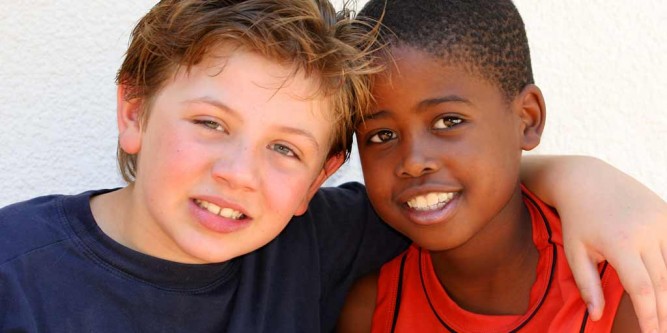“As iron sharpens iron, so a friend sharpens a friend” (Proverbs 27:17, NLT).
How Kids Think
Children ask each other, “Will you be my friend?” Most kids are desperate to “belong.” They are afraid of being excluded and want to fit in with their peers. But many children lack the ability to distinguish good friends from bad. They choose friends who do not reflect Christian values. These friendships can introduce perspectives that lead to poor decisions and habits that your child would not normally choose.
Social Development
Watching children navigate their social world is fascinating. Kids gain relational skills in the midst of family, school, and community interaction. Young children learn how to play cooperatively, resolve conflict, and share. As kids enter elementary school, friends become even more important. Children often gravitate to someone who becomes a best friend. Peer pressure develops; they start to worry about who likes them; they become sensitive to other relational differentiators as well. As children move into 3rd and 4th grade they form friendship groups; they can have issues with cliques and friend drama. By the pre-teen years, children begin to thrive in out-of-the-home activities and relationships. Friendships become central to these 11 and 12 year olds.
God’s Wisdom
The Lord created people to enjoy a variety of relationships. The first step to having good friends is being a good friend. King Solomon summed up friendship in one sentence: “A friend loves at all times, and a brother is born for adversity” (Proverbs 17:17). Solid, healthy friendships that develop over the course of time are of inestimable value.
Children need help navigating friendship conflicts, misunderstandings, and problems. It takes time to learn how to love, encourage, and build up others.
True Story
The school year was nearly over and my fourth graders were having a rough time—particularly the girls. Cliques had formed throughout the year and “drama” surfaced everywhere. I sat with Gabriella, whose strong personality drew many other girls to her, yet she was highly insecure. Much of the drama centered on her moods that tended to set the tone for day. I sat with Gabriella one afternoon and tutored her with her spelling. As we worked together, she inevitably directed the conversation to her friendship issues.
When Gabriella shared the latest drama, I noticed that inclusion and exclusion were usually at the core of every conflict. Someone felt left out, another was hurt by an idle comment, or allegiances shifted from one close friendship to another. In Gabriella’s case it was the latter—her close friend had started getting close to another girl and Gabriella felt betrayed. She chose to deal with her disappointment by making negative comments behind her friend’s back. This was creating division in the clique and girls were taking sides.
I thought, If they would just talk about it, so much drama could be avoided! I realized it was likely that Gabriella had no clue how to navigate a perceived betrayal. Her parents both worked two jobs and she was the eldest in the family. She had little parental mentoring and was learning from trial and error.
While we quizzed on spelling words, I prayed for wisdom. Then I asked Gabriella questions about what she had tried to reconcile with her friend. Does she know how much you like being her friend? I prodded. Have you reached out to her, or do you expect her to come to you? The questions shed light on Gabriella’s poor friendship skills. Her animated personality had created a quick bond, but Gabriella had taken her friend for granted, always expecting her to be there, but Gabriella had not shown appreciation back.
We brainstormed for a few minutes about ways Gabriella could encourage her friend. After finishing the spelling words, my young friend pulled out a piece of construction paper and started a letter to her alienated friend. The note was a small beginning. Gabriella was hesitant and afraid of her friend’s response—but she was determined to try. I was so proud of her efforts. She was starting to learn that loving well is the glue that holds friendships together!
What You Can Do
- Help your child search for good friends, just as he or she would seek valuable treasure.
- Discuss each phrase of 1 Corinthians 13:4-7 together, substituting the word “friends” for “love.”
- Consider how solid, healthy friendships—like great trees—take time and adversity to grow strong.
- Pray for your child: ask God to make him or her a good friend to others; pray that the Lord will also provide many good, lasting friendships.
- Brainstorm fun ways to do something that shows love for the friends in your child’s life. Help him or her put an idea into action!







